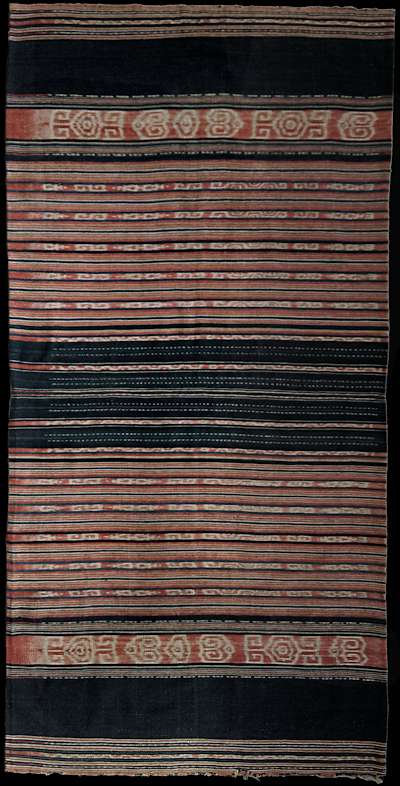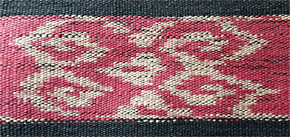| |
 
 | | | |
301 Moluccas, Babar
Roie irai (sarong) 
| | Locale: | Most likely Wetan, else Marsela or a Wetanese settlement on an island outside the Babar archipelago, e.g. one of the Tanimbars | | Period: | 19th to early 20th c. | | Yarn: | Cotton, hand-spun, very fine | | Technique: | Warp ikat | | Panels: | 2 | | Size: | 67 x 133 cm (2' 2" x 4' 4") LW: 1.99 | | Weight: | 515 g (18.2 oz), 289 g/m2 (0.95 oz/ft2) | | Design: | Prime example of the interculturality that characterizes the southern Moluccas. The field division is typical for Babar, very similar to that in PC 268. The main ikated bands carry motifs resembling a hexagon linked to pairs of right-angled inward curls. This motif is not common on Babar, but common on Tanimbar, there called 'loom' or 'breast-beam' (a pars pro toto for loom), and are also occasionally found on other nearby islands such as Kisar. The overall appearance strongly suggests Babar, not Tanimbar, though the dotted lines are more typical of Tanimbar, where they protect the village from attack (see PC 269). The prominent use of red, the number of ikated stripes in the middle section, and the wide plain indigo bands close to the extremities all conform to the Babar vernacular. The loom motifs are flanked by pairs of inward curls, more rounded than those in the loom motifs. These offer no clue as to origin since they are used across the region. | | Comment: | [PHOTOGRAPHY PROVISIONAL] Reds, not or rarely used on most islands of the Babar Archipelago, are most frequently seen on Wetan and Marsela, in that order. Consultatation of Babar and Tanimbar and experts suggests Wetan or a 'kampung Wetan' elsewhere as the most likely origin. The sarong clearly has seen intensive use, vide the frayed selvedges at the extremities, and it was nibbled on by a mouse, vide a 3 cm hole on the reverse. Surprisingly he colours are still saturated enough to let the motifs stand out clearly. A few pinstripes in light indigo liven up the mid section. The yarn has the wildly irregular gauge that is a hallmark of 19th and early 20th c. cloth. Note the low specific weight that resulted from the very fine hand-spun. | | Background: | Chapters on Moluccas and Babar. | | Published: | Ikat from Timor and its Outer Islands, 2022.
| | Compare: | 288 268 109 | | Sources: | Inward curls similar to those on Marsela sarong in the Toos van Dijk collection (see detail below). Main motif nearly identical to that on 19th c. Tanimbar sarong in Granucci, The Art of the Lesser Sundas, Fig. 119, though not quite as well drawn. The loom (breast beam) motif is shown in Van Vuuren, Ikat from Tanimbar on p. 149, Fig. 48, but Van Vuuren considers Tanimbar origin unlikely. Khan Majlis in Indonesische Textilien shows the same motif on a Kisar cawat from around 1900 on Abb. 494; also on a circa 1910 sarong from Luang on Abb. 527; and, in a more rounded version, on a circa 1900 Babar sarong from Marsela on Abb. 558 that also has a similar colour palette. Note the structural similarity with Babar sarongs PC 109 and 288.
 | | |

©Peter ten Hoopen, 2025
All rights reserved.
|
|


